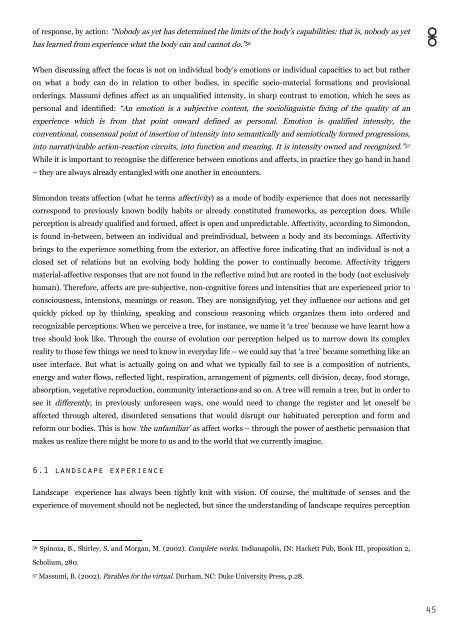Unfamiliar Territory_Research
Create successful ePaper yourself
Turn your PDF publications into a flip-book with our unique Google optimized e-Paper software.
of response, by action: “Nobody as yet has determined the limits of the body’s capabilities: that is, nobody as yet<br />
has learned from experience what the body can and cannot do.” 56<br />
⚮<br />
When discussing affect the focus is not on individual body’s emotions or individual capacities to act but rather<br />
on what a body can do in relation to other bodies, in specific socio-material formations and provisional<br />
orderings. Massumi defines affect as an unqualified intensity, in sharp contrast to emotion, which he sees as<br />
personal and identified: “An emotion is a subjective content, the sociolinguistic fixing of the quality of an<br />
experience which is from that point onward defined as personal. Emotion is qualified intensity, the<br />
conventional, consensual point of insertion of intensity into semantically and semiotically formed progressions,<br />
into narrativizable action-reaction circuits, into function and meaning. It is intensity owned and recognized.” 57<br />
While it is important to recognise the difference between emotions and affects, in practice they go hand in hand<br />
– they are always already entangled with one another in encounters.<br />
Simondon treats affection (what he terms affectivity) as a mode of bodily experience that does not necessarily<br />
correspond to previously known bodily habits or already constituted frameworks, as perception does. While<br />
perception is already qualified and formed, affect is open and unpredictable. Affectivity, according to Simondon,<br />
is found in-between, between an individual and preindividual, between a body and its becomings. Affectivity<br />
brings to the experience something from the exterior, an affective force indicating that an individual is not a<br />
closed set of relations but an evolving body holding the power to continually become. Affectivity triggers<br />
material-affective responses that are not found in the reflective mind but are rooted in the body (not exclusively<br />
human). Therefore, affects are pre-subjective, non-cognitive forces and intensities that are experienced prior to<br />
consciousness, intensions, meanings or reason. They are nonsignifying, yet they influence our actions and get<br />
quickly picked up by thinking, speaking and conscious reasoning which organizes them into ordered and<br />
recognizable perceptions. When we perceive a tree, for instance, we name it ‘a tree’ because we have learnt how a<br />
tree should look like. Through the course of evolution our perception helped us to narrow down its complex<br />
reality to those few things we need to know in everyday life – we could say that ‘a tree’ became something like an<br />
user interface. But what is actually going on and what we typically fail to see is a composition of nutrients,<br />
energy and water flows, reflected light, respiration, arrangement of pigments, cell division, decay, food storage,<br />
absorption, vegetative reproduction, community interactions and so on. A tree will remain a tree, but in order to<br />
see it differently, in previously unforeseen ways, one would need to change the register and let oneself be<br />
affected through altered, disordered sensations that would disrupt our habituated perception and form and<br />
reform our bodies. This is how ‘the unfamiliar’ as affect works – through the power of aesthetic persuasion that<br />
makes us realize there might be more to us and to the world that we currently imagine.<br />
6.1 landscape experience<br />
Landscape experience has always been tightly knit with vision. Of course, the multitude of senses and the<br />
experience of movement should not be neglected, but since the understanding of landscape requires perception<br />
56<br />
Spinoza, B., Shirley, S. and Morgan, M. (2002). Complete works. Indianapolis, IN: Hackett Pub, Book III, proposition 2,<br />
Scholium, 280.<br />
57<br />
Massumi, B. (2002). Parables for the virtual. Durham, NC: Duke University Press, p.28.<br />
45


